| |
| |
Photographer,
Location |
Images |
Comments |
|
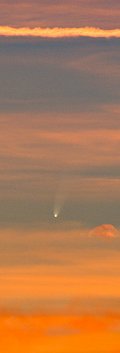
|
Diego Meozzi,
Trevignano Romano, Italy
Jan. 12, 2007 |
#1 |
The comet was
very low on the horizon, so the tail was much less visible
than the previous days. However, the clouds at sunset were
spectacular!
Photo
details: Nikon
D200, Nikkor 300 mm lens, f/2.8, ISO 100, 1/80s
|
|

|
Mark Seibold,
Troutdale, Oregon.
Jan. 11, 2007 |
#1 |
After arriving
at a hilltop with a clear view of the western horizon over
Portland 25 miles to the west, I could not believe I was
seeng the comets nucleus and a degree or so of tail only
15 minutes after sunset with the naked eye! I have seen
perhaps 2 dozen comets since my first at age 3 in 1957 (Comet
Mrkos or Arend-Rolland) also including the brightest being
Comet Bennet in 1970, West in 1976, Halley's in 1986, Hyakutake
in 1996, Hale-Bopp in 1997 but I have never seen one this
bright in daylight. Both sketches are after observing through
7
X 50 binoculars. The first sketch from 5:15 PM PST at
left is the nucleus and partial tail in near daylight; the
second is after the comet dropped into a deep red-orange
haze by 5:35 PM PST. Mark Seibold
|
|
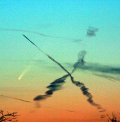
|
Harry W Wood,
west of Des Moines Iowa
Jan. 10, 2007 |
#1 |
The comet was
sliding down the sky as jet contrails crossed the sky.
Photo
details: Canon
10D, 28-300 lens, f5.6, 1/2 second exposure.
|
|

|
Jim Fakatselis,
Taken at Robert Moses State Park, Babylon, NY
Jan. 11, 2007 |
#1 |
An airplane taking off from nearby JFK airport jets away from NYC as does the comet from the Northern Hemisphere.
|
|
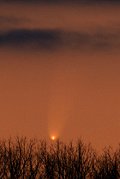
|
Imelda Joson and Edwin Aguirre,
Horn Pond, Woburn, Massachusetts
Jan. 12, 2007 |
#1,
|
We first spotted
the comet through binoculars about 5 minutes BEFORE sunset.
The comet's head was so bright it was visible in broad daylight
to the naked eye! It looked like a very bright star with
a short, stubby tail. The tail's appearance was less dramatic
compared to last night, owing to the comet's proximity to
the Sun in the sky, which lessened the contrast between
the tail and the twilight sky.
Photo
details: Canon
EOS 20D digital SLR camera, Takahashi FS-78 f/8 refractor;
exposure time was 1/6 second at ISO 100.
|
|

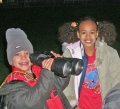
|
Brian Whittaker,
Birmingham, England.
Jan. 10, 2007 |
#1,
#2, more |
I was amazed! The clouds parted, and there it was! The brightest Comet that I had ever seen! What a delight to see, and show the family. Everyone could see the bright tail, just like in the pictures. Best ever.
|
|
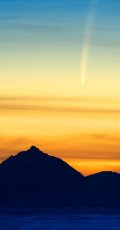
|
Torgeir
Sorensen,
Sortland, Norway
Jan. 11, 2007 |
#1,
#2, #3,
more |
Yesterday we could experience the beautiful McNaught comet in a beautiful weather here at Sortland. The last month's the weather has not been any good so it was a great luck that I got the opportunity to take these pictures of the comet in this light.
|
|
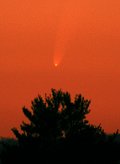
|
Tim Printy,
Manchester NH
Jan. 12, 2007 |
#1,
#2 |
Comet
McNaught has brightened greatly in the past few days. Clouds
interfered the past two nights and I was fortunate to have
clear weather this evening. I saw the comet with 7X50
binoculars at sunset and it was visible to the naked
eye about 15 minutes later. The magnitude of the comet appeared
to be about -3 and it had a tail that was about 1-2 degrees
long. People in the southern hemisphere are going to get
quite a show.
Photo
details: Nikon
D70 set at ISO 200 using a 120mm F5 refractor (600mm
fl). Exposure times were 1/40 and 1/60 sec.
|
|
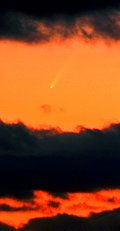
|
John E Cordiale,
Argyle, NY
Jan. 10, 2007 |
#1 |
"I had been
fighting the weather for 5 days trying to get a picture
of it.
Photo
details: Canon
350D, 0.4 sec exposure, 200mm Tamron Lens."
|
|
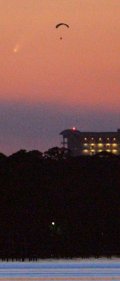
|
Terry Barner,
Panama City, Florida, USA
Jan. 10, 2007 |
#1 |
Because of clouds,
the comet was only seen for about one minute about 25 minutes
after sunset and one needed binoculars or a telescope to
see it clearly.
Photo
details: Canon
EOS-1 Mark II, 400mm lens, ISO 3200, f/2.8, 1/100 second
|
more
images: from Denis
Boucher of St-Albert, Alberta, Canada; from
Gianluca Masi and Gabriele Catanzaro of Rome, Italy; from
Mark Stewart of Seattle, Washington; from
Dean Forbes of Shoreline, Washington; from
Jayme Hanzak of Hillsborough, North Carolina; from
Steve Scudero of Berkeley Hills, California; from Peter Lyberth
of Nuuk, Greenland; from
Tudorica Alexandru of Magurele, near Bucharest; from
Velimir Popov of Mountain Vitosha, Sofia, Bulgaria; from
Grahame Robertson of West Lothian, Scotland; from
Pat Boomer near Red Deer, Alberta, Canada; from
Sue Nichols of Lind Coulee, Washington; from
Andy Fu of Mountain View, California; from
Brian Maky on Wolf Mountain Lookout near Grass Valley, California;
from Dan Charrois
of Legal, Alberta, Canada; from
Richard Nolthenius of Santa Cruz, California; from
Jeff McIntosh of Cremona, Alberta, Canada; from
Tim Ratzlaff of Monroe, Washington; from
Bob Norton of Albuquerque, NM; from
Bob King of Duluth, Minn; from
John Liddard of Lower Sackville, Nova Scotia, Canada. |
|